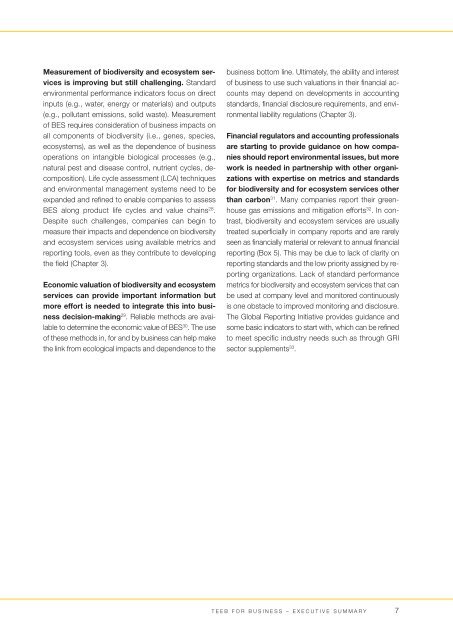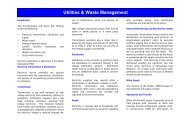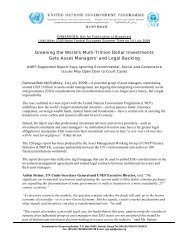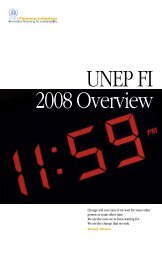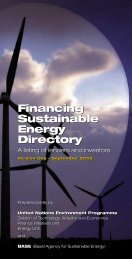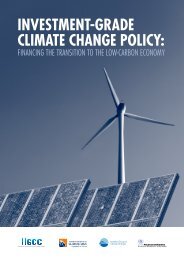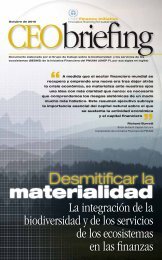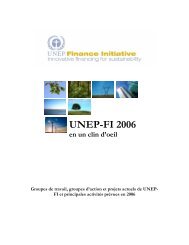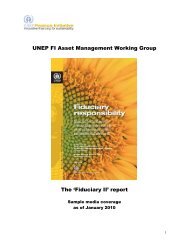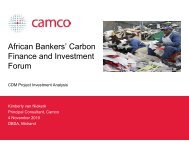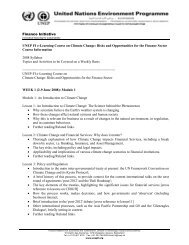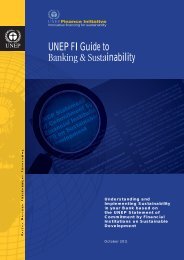for Business - TEEB
for Business - TEEB
for Business - TEEB
Create successful ePaper yourself
Turn your PDF publications into a flip-book with our unique Google optimized e-Paper software.
Measurement of biodiversity and ecosystem services<br />
is improving but still challenging. Standard<br />
environmental per<strong>for</strong>mance indicators focus on direct<br />
inputs (e.g., water, energy or materials) and outputs<br />
(e.g., pollutant emissions, solid waste). Measurement<br />
of BES requires consideration of business impacts on<br />
all components of biodiversity (i.e., genes, species,<br />
ecosystems), as well as the dependence of business<br />
operations on intangible biological processes (e.g.,<br />
natural pest and disease control, nutrient cycles, decomposition).<br />
Life cycle assessment (LCA) techniques<br />
and environmental management systems need to be<br />
expanded and refined to enable companies to assess<br />
BES along product life cycles and value chains 28 .<br />
Despite such challenges, companies can begin to<br />
measure their impacts and dependence on biodiversity<br />
and ecosystem services using available metrics and<br />
reporting tools, even as they contribute to developing<br />
the field (Chapter 3).<br />
Economic valuation of biodiversity and ecosystem<br />
services can provide important in<strong>for</strong>mation but<br />
more ef<strong>for</strong>t is needed to integrate this into business<br />
decision-making 29 . Reliable methods are available<br />
to determine the economic value of BES 30 . The use<br />
of these methods in, <strong>for</strong> and by business can help make<br />
the link from ecological impacts and dependence to the<br />
business bottom line. Ultimately, the ability and interest<br />
of business to use such valuations in their financial accounts<br />
may depend on developments in accounting<br />
standards, financial disclosure requirements, and environmental<br />
liability regulations (Chapter 3).<br />
Financial regulators and accounting professionals<br />
are starting to provide guidance on how companies<br />
should report environmental issues, but more<br />
work is needed in partnership with other organizations<br />
with expertise on metrics and standards<br />
<strong>for</strong> biodiversity and <strong>for</strong> ecosystem services other<br />
than carbon 31 . Many companies report their greenhouse<br />
gas emissions and mitigation ef<strong>for</strong>ts 32 . In contrast,<br />
biodiversity and ecosystem services are usually<br />
treated superficially in company reports and are rarely<br />
seen as financially material or relevant to annual financial<br />
reporting (Box 5). This may be due to lack of clarity on<br />
reporting standards and the low priority assigned by reporting<br />
organizations. Lack of standard per<strong>for</strong>mance<br />
metrics <strong>for</strong> biodiversity and ecosystem services that can<br />
be used at company level and monitored continuously<br />
is one obstacle to improved monitoring and disclosure.<br />
The Global Reporting Initiative provides guidance and<br />
some basic indicators to start with, which can be refined<br />
to meet specific industry needs such as through GRI<br />
sector supplements 33 .<br />
T E E B F O R B U S I N E S S – E X E C U T I V E S U M M A R Y 7


